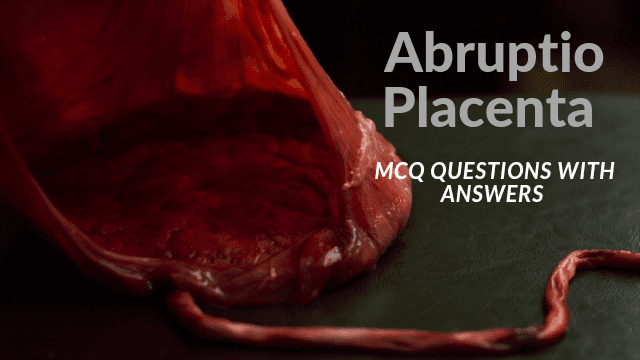Multiple-choice questions with answers related to Abruptio Placenta, based on different scenarios
Scenario 1: Sarah is a 34-year-old woman who is 36 weeks pregnant. She presents to the hospital with vaginal bleeding and abdominal pain. Upon examination, the obstetrician notices that the baby's heart rate is decelerating. What is the most likely diagnosis?
A. Placenta previa B. Ectopic pregnancy C. Abruptio placenta D. Normal pregnancy
Answer: C. Abruptio placenta is the most likely diagnosis in this scenario, as it is characterized by vaginal bleeding and abdominal pain, and can cause fetal distress.
Scenario 2: Lisa is a 28-year-old woman who is 38 weeks pregnant. She presents to the hospital with sudden, severe abdominal pain and vaginal bleeding. The obstetrician notes that her uterus is tender and firm. What is the most likely diagnosis?
A. Placenta previa B. Ectopic pregnancy C. Abruptio placenta D. Normal pregnancy
Answer: C. Abruptio placenta is the most likely diagnosis in this scenario, as it is characterized by sudden, severe abdominal pain and vaginal bleeding, and the uterus may be tender and firm.
Scenario 3: John is a 40-year-old man whose wife is 28 weeks pregnant. He notices that she is experiencing frequent contractions and has sudden, severe abdominal pain. They rush to the hospital, and the obstetrician notes that the baby's heart rate is normal. What is the most likely diagnosis?
A. Placenta previa B. Ectopic pregnancy C. Abruptio placenta D. Normal pregnancy
Answer: D. In this scenario, the most likely diagnosis is a normal pregnancy, as frequent contractions and abdominal pain are common symptoms in later stages of pregnancy.
Scenario 4: Maria is a 26-year-old woman who is 30 weeks pregnant. She presents to the hospital with vaginal bleeding and abdominal pain. Upon examination, the obstetrician notes that the baby's heart rate is normal. What is the most likely diagnosis?
A. Placenta previa B. Ectopic pregnancy C. Abruptio placenta D. Normal pregnancy
Answer: A. Placenta previa is the most likely diagnosis in this scenario, as it is characterized by vaginal bleeding and the baby's heart rate is usually normal. However, further investigations are needed to confirm the diagnosis.
Scenario 5: Mrs. Johnson, a 35-year-old pregnant woman at 32 weeks gestation, arrives at the emergency department with sudden onset of severe abdominal pain and vaginal bleeding. She is hypotensive, tachycardic, and complains of intense uterine tenderness. Fetal heart rate monitoring shows late decelerations. What is the most likely diagnosis?
A) Placenta previa
B) Ectopic pregnancy
C) Abruptio placenta
D) Uterine rupture
Answer: C) Abruptio placenta
Scenario 6: A 38-year-old pregnant woman at 35 weeks gestation presents with vaginal bleeding and constant abdominal pain. The bleeding is dark red, and she reports no prior episodes of bleeding during the pregnancy. On physical examination, her uterus feels firm and board-like. The fetal heart rate is non-reassuring. Which of the following is the most appropriate initial step in management?
A) Administer tocolytic therapy
B) Perform an emergent cesarean delivery
C) Obtain maternal and fetal blood samples for laboratory testing
D) Administer intravenous fluid resuscitation
Answer: B) Perform an emergent cesarean delivery
Scenario 7: A 28-year-old pregnant woman at 28 weeks gestation is brought to the labor and delivery unit due to sudden-onset vaginal bleeding. She is tachycardic, hypotensive, and experiences intense abdominal pain. The uterine fundus is firm, and the fetal heart rate is undetectable. Which of the following is the most appropriate next step in management?
A) Perform an emergent cesarean delivery
B) Administer intravenous fluids and blood transfusion
C) Administer tocolytic therapy
D) Perform a manual removal of the placenta
Answer: A) Perform an emergent cesarean delivery
Scenario 8: A 25-year-old woman at 39 weeks gestation presents with sudden-onset vaginal bleeding and sharp abdominal pain. On examination, her blood pressure is normal, but she has a tachycardia. The uterus is tender, and fetal heart rate monitoring reveals late decelerations. Which of the following is the most likely diagnosis?
A) Placenta previa
B) Ectopic pregnancy
C) Abruptio placenta
D) Uterine rupture
Answer: C) Abruptio placenta
Scenario 9: A 32-year-old pregnant woman at 30 weeks gestation arrives at the emergency department with complaints of sudden-onset abdominal pain and vaginal bleeding. On examination, her blood pressure is 140/90 mmHg, and she has a bounding pulse. The uterus is tender, and fetal heart rate monitoring shows variable decelerations. Which of the following is the most appropriate next step in management?
A) Administer tocolytic therapy
B) Administer intravenous fluids and blood transfusion
C) Perform an emergent cesarean delivery
D) Administer anticoagulant therapy
Answer: C) Perform an emergent cesarean delivery

Comments
Post a Comment